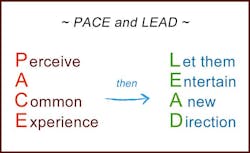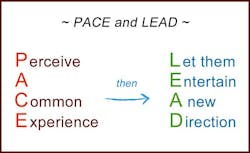From the Hypnodontist: Pace and lead for greater case adherence
Pacing and leading are terms from hypnosis and NLP that refer to meeting people where they are, and then pointing them where you'd like them to go. Last month's Hypnodontist column described how this approach can be an important part of increasing case acceptance.(1) This article discusses pacing and leading in more detail to help you acquire greater adherence from your patients.
Good morning John. You're on time for an 8 am Monday appointment – we really appreciate that! The doctor made your night guard based on the impression we took last time you were here. As you try it on now, here is some information to read about the hypnodontist who can help you stop grinding. In the meantime, because you want your wife to sleep better, it's important that you wear the night guard every night while you sleep.
Note the details of that last paragraph need to match what is accurate in the experience of the patient. Pointing out the day and time (and even where you are) is often a convenient way to start establishing agreement about what is true. Stating the observable actions being taken by you or the other person is also a good pacing strategy. Repeating what someone has told you can have many benefits. In this context, the prime value is using one of the main principles of influence identified by Dr. Cialdini – people's natural commitment to maintaining consistency.
Final thought – look again at the last words of the leading part of the night guard example – wear the night guard every night while you sleep. This is called an embedded command, an action step or instruction placed within the ordinary flow of speaking where it doesn't come across as bossy or ordering someone around. I did the same thing earlier when I said read this article to the end. Embedded commands are a great nuance of "being hypnotic" that will be explored further in a future Hypnodontist column.
Dave Berman, C.Ht. trains dental professionals to use the language of ethical influence, practicing hypnodontics, and hypnotherapy in the San Diego area. For more information, visit Hypnodontist.com or call 858-876-7930.
References
1. http://www.dentistryiq.com/articles/2014/07/hypnodontist-increasing-case-acceptance.html
2. http://www.dentistryiq.com/articles/2014/07/because-words-matter.html
3. Cialdini, Robert (2006). Influence: The Psychology of Persuasion. New York: Collins Business Essentials.



